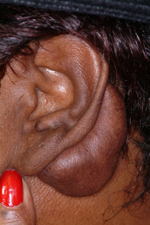Keloids are a notoriously difficult scar problem for which there is no match other than perhaps that of the broader-based burn scar. There are a wide variety of treatments used for keloids and that is a testament to their high recurrence rate despite what treatment method is done.

How effective is earlobe keloid scar treatment, particularly when radiation is used? In the November 2013 issue of the journal Plastic and Reconstructive Surgery, an article entitled ‘Analysis of Surgical Treatments for Earlobe Keloids: Analysis of 174 Lesions in 145 Patients’. Over a five year period, earlobe keloids (85% primary, 15% recurrent) were treated by a variety of treatments including radiation. The postsurgical radiotherapy modalities were 15 Gy administered in three fractions over 3 days and 10 Gy administered in two fractions over 2 days. Recurrence over the following eighteen months was near 5% in the primary group and 0% in the recurrent earlobe keloid group. No differences were seen in those keloids treated with 15-Gy and 10-Gy postsurgical radiotherapy in terms of rate of recurrence.
What this study shows is that low-dose radiation may be the most effective form of earlobe keloid scar revision and may even be considered as an initial therapy with surgery as the first effort. Given that there appears to be no difference with the lower dose approach, postsurgical radiotherapy with 10 Gy of radiotherapy administered in two fractions over 2 days can be successfully used to treat earlobe keloids.
Dr. Barry Eppley
Indianapolis, Indiana


